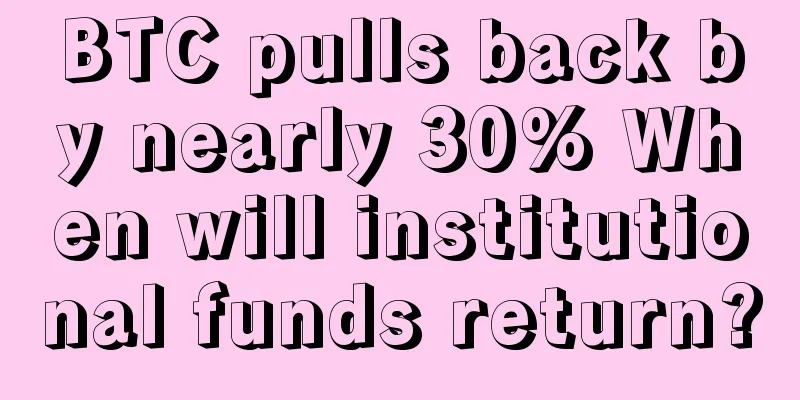BTC pulls back by nearly 30% When will institutional funds return?

|
According to the latest “Bitfinex Alpha” report, BTC’s price is waiting for long-term holders or institutional demand to absorb the recent selling pressure from short-term holders . BTC’s decline since hitting an all-time high of $109,590 on Jan. 20 has heightened concerns about the role of institutional investors in sustaining market momentum. The recent drop below $77,000 marked a 29.7% correction from the peak, making it the second-largest correction in the current bull cycle. Historically, a 30% correction has often heralded a market rebound, but current conditions suggest that “deep pockets” have not yet fully absorbed the selling pressure. Institutional Fund Flows and Market StabilityInstitutional adoption of BTC, driven primarily by spot BTC ETFs and corporate accumulation , has played a key role in reducing the depth of the correction in this market cycle. Past pullbacks have ranged between 18% and 22%, highlighting that pullbacks are becoming more gradual. However, the current 29.7% decline suggests that institutional support has weakened. The report pointed out that ETF outflows reached $921.4 million on four of the five trading days last week, further reinforcing this trend. Without a new round of buying from institutional investors, BTC may face the risk of long-term price consolidation or further decline. Selling pressure intensifiesMarket data shows that short-term BTC holders (STH), defined as “wallet addresses that have held BTC for less than 180 days,” are increasingly selling at a loss. STH saw a net unrealized loss when prices fell below $90,000, which has historically been a catalyst for increased selling pressure. A particularly vulnerable segment of this group is the “shrimp” addresses, or holders who hold less than 1 BTC and tend to sell BTC when prices rebound to get out of their positions after a long period of unrealized losses. The recent trend in BTC buyers’ cost basis further illustrates the weakening demand . In a strong market, the cost basis of those who bought BTC in the past 7 days to 30 days will generally be higher than those who bought 1 month to 3 months ago, indicating bullish market sentiment. However, this pattern reversed in the first quarter of 2025, with new entrants hesitant to digest the market supply. This shift coincided with BTC’s drop below $90,000, reflecting a shift from post-all-time high momentum to a risk-off environment. Key indicators reflect wait-and-see sentimentThe short-term holder spending output profit ratio (STH-SOPR) is a key indicator for assessing the current selling pressure on BTC. It measures whether STH is selling at a profit or loss. The 30-day moving average of STH-SOPR has remained below 1 since BTC fell below $95,000, indicating that most short-term investors are selling at a loss . The indicator, which has a neutral zone of 1, fell to 0.97 when BTC briefly reached $78,000. This move marked one of the most dramatic capitulation events in this cycle. Continued downward pressure has led to a more cautious sentiment in the broader market, prompting short-term players to continue selling. Historically, such conditions have signaled localized seller exhaustion, where weaker investors leave the market and stronger hands begin to accumulate again. Long-term investors often monitor these conditions for potential re-entry opportunities, recognizing that a deeply negative STH-SOPR reading can serve as a counter-trend buy signal. The report noted that as BTC experiences one of its most significant pullbacks in this cycle, the reaction of institutional investors will be crucial in determining the next phase of the market’s trajectory . If institutional capital returns in large amounts, it could provide the necessary support for a recovery in BTC prices. However, without renewed interest from deep-pocketed investors, BTC price action could remain subdued, either continuing to fluctuate within a range or falling further. |
<<: L2 is making a lot of money, but Ethereum has become a "tool". How to change the status quo?
Recommend
The most auspicious facial features
Different people have different fortunes due to t...
What does a black forehead indicate for a person with the Fire element in the Mountain? What will happen if a black forehead appears?
The blackness of the Fire Marks on the forehead i...
Ditian Jushi: What does it mean when the lines on the palm are broken?
Some of our friends have broken lines on their pa...
Bitcoin Wallet iPayYou Launches Bitcoin Payment Function on Twitter
Bitcoin wallet iPayYou has launched a Twitter pay...
Analyzing the child's fortune through facial features
Analyzing the child's fortune through facial ...
Data: After ETH surged, the market's willingness to buy increased, but long-term holders tend to transfer tokens
According to news on May 12, ETH has continued to...
Analyzing your personality based on your eyes? What is your personality like?
Everyone has eyes. Some people have big eyes, some...
Is a person with a sunken forehead a good or bad face? What does a sunken forehead indicate?
People with sunken foreheads have bad luck. From ...
What are we talking about when we talk about Bitcoin?
Author: Velvet Gold Mine As long as a system requ...
Should I invest in Bitcoin? An investor's story
This article is about an investor who owns Bitcoi...
Only want to develop in big cities
Nowadays, everyone wants better development. Some...
What are the ten unlucky palm features and what are the consequences?
What are the ten most unlucky palm features? Ever...
Bitcoin approaches halving event as analysts speculate on price trends
Bitcoin (BTC) is less than six months away from i...
Will people with cone-shaped faces have a good marriage?
When it comes to cone-shaped faces, the first per...
Women need to avoid these things if they want to be rich
In life, some people are born with a rich destiny...









